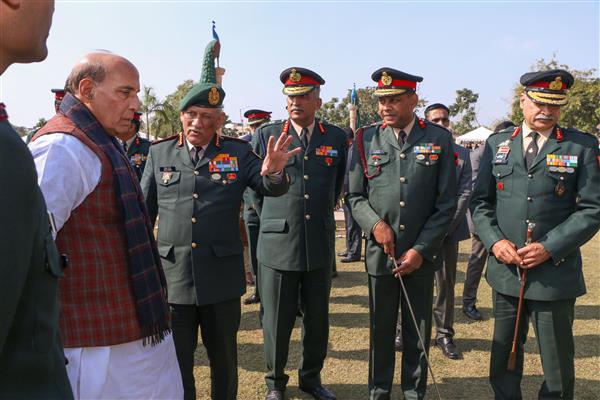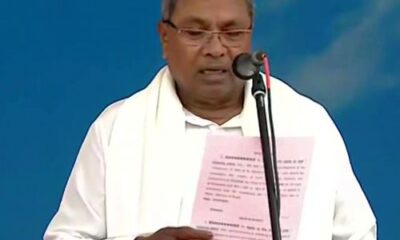National
Navratri: Harmonising ancient wisdom with modern understanding
New Delhi, April 5 (IANS) Navratri, a significant festival among Hindus, derives its name from the Sanskrit term meaning ‘time of nine nights’. During these ten days and nine nights, devotees worship Shakti/Devi.
Navratri occurs four times annually, during the lunar months of Chaitra, Magh, Ashadha, and Ashwin (Kartik) from Pratipada to Navami.
Chaitra hosts the Vasantik or Vasantiya Navratri, while Ashwin marks the Shardiya Navratri. Navratri during Magh and Ashadha is known as Gupt Navratri.
The festival concludes with the immersion of the Durga idol on Dussehra.
Notably, there is a three-month gap between each Navratri celebration.
In the context of Hinduism, the practice of worshipping feminine energy (shakti), represented by nine Goddesses, for nine consecutive days during festivals, is unmatched by any similar practice in other religions.
This distinctive aspect underscores the central role of Goddess worship within Hindu observances, showcasing the deep reverence for women and femininity embedded in Hindu culture since antiquity.
Across epochs, Hinduism has boasted the most pronounced presence of the divine feminine among global religions, signifying an enduring legacy of empowerment and reverence for the feminine essence.
The celebration of Navratri embodies the reverence for feminine energy (shakti) depicted in Hindu scriptures. Just as the Rigveda glorifies feminine energy as the essence of the universe, Navratri celebrates the divine feminine through Goddess Durga, Lakshmi, and Saraswati.
These goddesses symboliSe purification cycles, mirroring the journey of purification depicted in ancient texts.
The first cycle, represented by Goddess Durga, purifies the physical realm, akin to the glorification of feminine energy as the creator in Hindu scriptures.
Similarly, the second cycle, led by Goddess Lakshmi, focuses on emotional purification, aligning with the empowering depiction of women in Hindu texts.
Finally, the third cycle, guided by Goddess Saraswati, signifies the purification of the mind, reflecting the supreme governing principle of the cosmos attributed to the feminine in Vedic literature.
Thus, Navratri’s rituals echo the profound respect and celebration of women as formidable and empowering entities in Hinduism, as depicted in ancient scriptures.
Why should we seize this opportunity to purify our bodies and minds?
Let’s delve into the scientific rationale behind Navratri. One distinguishing feature of Hindu festivals is their inherent connection to significant astronomical events or transitions.
Navratri aligns with crucial astronomical events like Equinoxes and Solstices, which are pivotal in marking the change of seasons.
During the equinox, the sun aligns directly with the equator, creating approximately equal lengths of daylight and darkness worldwide.
This celestial event, derived from the Latin words “equity” and “nox” meaning equal night, marks a balance between light and darkness, with most places experiencing 12 hours of each.
At the equator, the sun is directly overhead during these equinoxes, occurring only twice a year when the Earth’s axis is neither tilted towards nor away from the sun, resulting in nearly equal amounts of daylight and darkness across latitudes.
They match well with our body’s internal clock, called the circadian rhythm, which dictates when we sleep, wake, and perform other biological functions.
Our internal clock runs slightly longer than a 24-hour day but adjusts to the environment’s light-dark cycle. This adjustment, known as entrainment, prevents our cycles from drifting.
Balanced lightness and darkness during equinoxes keep our circadian system stable, ensuring better sleep and well-being.
Physiologically, hormonal shifts occur during this time, influencing various biological cycles and promoting inner transformation.
With rising consciousness during Navratri meditations aids in decluttering the mind of negative emotions such as fear, anger, and attachment, fostering mental well-being.
The March equinox also heralds spring, symbolizing renewal and rejuvenation.
Across cultures, this time is celebrated as nature’s awakening, with trees and plants completing their growth cycle, adorned with vibrant spring foliage or blossoms before the arrival of summer.
The eternal and limitless spirit (soul) journeyed through the ages, acting as an unending source of energy in the universe.
Navratri, the nine sacred nights of India’s spiritual festival through fasting, prayer, chanting, and meditation offer a chance to convert negativity into positivity.
These significant nights mark a period for awakening, integrating, and aligning the nine chakras across the mind, body, and spirit.
During Navratri, the subtle energies enveloping the surroundings aid in guiding one’s path towards spiritual enlightenment, forging a link between personal awareness and the divine, auspicious collective consciousness.
This connection evokes positive attributes within us, dismantling lethargy, conceit, fixation, desires, and repulsions.
As negative emotions dissipate, replaced by transformative energies, we embark on a journey of profound rejuvenation throughout the auspicious nine nights.
Interestingly, the concept of feminine energy finds a parallel in the biological realm through mitochondria, often referred to as the powerhouse of the cell. Mitochondria, inherited from the maternal DNA, play a crucial role in providing energy to the human body.
This connection underscores the deep reverence for the feminine essence embedded in Hindu culture.
During Navratri, devotees engage in rituals such as fasting, prayer, chanting, and meditation, seeking spiritual enlightenment and purification.
These practices have been likened to intermittent fasting, which has been associated with mitochondrial rejuvenation.
Fasting triggers processes like autophagy and mitochondrial biogenesis.
Autophagy clears out damaged mitochondria, while biogenesis stimulates the formation of new, healthy ones. This renewal process parallels the spiritual journey of Navratri, where devotees strive for inner purification and renewal.
Moreover, intermittent fasting of Navratri enhances mitochondrial efficiency and function, reducing oxidative stress and promoting cellular health.
Similarly, Navratri rituals aim to cleanse the mind, body, and spirit, offers an ideal opportunity to sync and balance the internal and external energy centers, fostering spiritual integration and harmony.
Navratri holds profound significance, intertwining spiritual, social, and scientific dimensions.
From a social perspective, traditionally in Bharat, there was no concept of weekends or Sundays, so the Hindu festivals like Navratri used to provide a respite from the rigors of daily life, reminding individuals to pause and reconnect through community interactions, revitalising old relationships and fostering new connections amidst seasonal change.
The attributes like strength and stability, devout asceticism, courage, protection, and determination are essential qualities for navigating life’s challenges. Additionally, the ability to combat evils, create positive change, and embody purity and recovery contribute to a well-rounded and evolved existence.
Each of these attribute symbolised by the nine forms of the divine Goddess Durga is integral to achieving spiritual growth, fulfilment, and ultimately, a harmonious and evolved life.
In the rich tradition of Hinduism in Bharat, the intertwining of science and culture is not only evident but celebrated.
Navratri, with its profound spiritual significance and scientific underpinnings, exemplifies this harmonious co-existence.
As devotees come together to honour the divine feminine and embark on a journey of purification and enlightenment, they simultaneously embrace the scientific insights that guide their practices.
In this fusion of ancient wisdom and modern understanding, Hinduism in Bharat continues to thrive, offering a timeless path to spiritual growth and cultural richness.
(The writer is a Ph.D in sociology and has authored books on India History)
–IANS
vinay/pgh
National
Defence Ministry: Year 2025 will be year of reforms

On Wednesday, the Defence Ministry announced that 2025 will be designated as the “Year of Reforms,” with a primary focus on establishing integrated theatre commands to enhance collaboration among the three branches of the military.
These reforms are aimed at transforming the armed forces into a technologically advanced, combat-ready force capable of executing multi-domain integrated operations, the ministry stated.
The initiative will emphasize emerging domains such as cyber and space, alongside cutting-edge technologies like artificial intelligence, machine learning, hypersonics, and robotics.
Defence Minister Rajnath Singh described the “Year of Reforms” as a pivotal milestone in the modernization of the armed forces.
“It will set the stage for significant advancements in the nation’s defense capabilities, ensuring the security and sovereignty of India in the face of 21st-century challenges,” he said.
National
A 3.2 magnitude tremor struck Gujarat’s Kutch district on Wednesday morning

A 3.2 magnitude tremor struck Gujarat’s Kutch district on Wednesday morning, according to the Institute of Seismological Research (ISR).
The district administration reported no casualties or property damage following the quake.
The tremor occurred at 10:24 am, with its epicenter located 23 kilometers north-northeast (NNE) of Bhachau, as per the Gandhinagar-based ISR.
Last month, the region experienced four seismic events exceeding a magnitude of 3, including a 3.2 magnitude tremor just three days ago, with its epicenter also near Bhachau.
Earlier tremors in the area included a 3.7 magnitude earthquake on December 23 and a 3.2 magnitude event on December 7, according to ISR reports.
Kutch was also jolted by a 4.0 magnitude earthquake on November 18, 2024. On November 15, a 4.2 magnitude quake hit Patan in north Gujarat, based on ISR data.
Gujarat is considered a high-risk earthquake zone, having experienced nine major earthquakes over the past 200 years, according to the Gujarat State Disaster Management Authority (GSDMA). The 2001 earthquake in Kutch, which occurred on January 26, was the third-largest and second-most destructive in India in the last two centuries, according to the GSDMA.
National
Diljit Dosanjh faces legal action over concert songs

Singer and actor Diljit Dosanjh’s much-anticipated New Year’s Eve concert in Ludhiana faced legal hurdles after a complaint was filed by Punditrao Dharenavar, an assistant professor from Chandigarh.
Following the complaint, the Deputy Director of the Women and Child Department, Government of Punjab, issued a formal notice to Ludhiana’s District Commissioner, urging them to prohibit Dosanjh from performing specific songs during his live show on December 31, 2024.
The notice specifically targets songs accused of promoting alcohol, including Patiala Peg, 5 Tara Theke, and Case (Jeeb Vicho Feem Labbiya), even if the lyrics are slightly modified. The complaint points to previous warnings issued to Dosanjh by various commissions advising against performing these controversial tracks.
Despite these warnings, the singer allegedly continues to perform the songs with minor alterations. Dharenavar raised serious concerns about the influence of such music on young audiences, especially when minors are present at live events.
Adding to the controversy, Dharenavar referenced a 2019 Punjab and Haryana High Court ruling, which directed law enforcement to ensure that songs promoting alcohol, drugs, or violence are not played at public events, including concerts. This ruling underscores the legal basis for the complaint and has further intensified the scrutiny surrounding the event.
National
UP Minister’s convoy overturns, 5 person injured

Five people sustained injuries when a vehicle in the convoy of Uttar Pradesh Minister and Nishad Party chief Sanjay Nishad overturned into a ditch near Januan village in the Khejuri Police Station area of Ballia district late last night.
Sanjay Nishad shared details of the incident, stating that the accident injured five party workers, including four women.
“I was traveling with the convoy to participate in the Constitutional Rights Yatra organized by the party on Tuesday night. Near Januan village in the Khejuri area, one of the vehicles following the convoy lost control while trying to avoid an animal and overturned into a ditch,” Nishad explained.
The injured individuals have been identified as Rakesh Nishad, Ramrati, Usha, Geeta, and Iravati Nishad.
Senior police and administrative officials quickly arrived at the scene following the incident to oversee the situation.
National
Suchir Balaji’s mother alleges Murder


The mother of Suchir Balaji, a 26-year-old former OpenAI researcher found dead after accusing the company of copyright violations, has alleged that her son was “murdered” and called for a Federal Bureau of Investigation (FBI) probe.
Poornima Rao, Suchir’s mother, claimed her son’s death was a “cold-blooded murder” that authorities wrongly ruled as suicide. She further disclosed that a private autopsy report conflicted with the findings of the initial police investigation.
Rao alleged that her son’s apartment had been “ransacked” and cited evidence of a struggle in the bathroom, including bloodstains that suggested he had been assaulted.
“We hired a private investigator and conducted a second autopsy to uncover the truth. The private autopsy does not confirm the cause of death stated by the police. Suchir’s apartment was ransacked, there were signs of a struggle in the bathroom, and it appears he was hit based on blood spots. This is a cold-blooded murder being misclassified as a suicide. Lobbying in San Francisco won’t deter us from seeking justice. We demand an FBI investigation,” Rao wrote on X.
Elon Musk reacted to Rao’s post, commenting, “This doesn’t seem like a suicide.”
Balaji was discovered dead in his San Francisco apartment months after accusing OpenAI of violating copyright laws during the development of ChatGPT, as reported by Fox News. Despite these claims, the San Francisco Police Department found no evidence of foul play and ruled the death a suicide.
On October 24, shortly before his death, Balaji voiced doubts about the “fair use” defense in generative artificial intelligence. “I recently participated in a NYT story about fair use and generative AI, and why I’m skeptical ‘fair use’ would be a plausible defense for a lot of generative AI products,” he wrote on X.
-
Video2 years ago
PM Modi Attacks Congress in Karnataka with “Kerala Story”
-
Politics2 years ago
Siddaramaiah & DK Shivakumar sworn in as Chief Minister & Deputy CM respectively
-
Cricket2 years ago
CSK players rejoice 5th IPL title with their families (Pics)
-
Entertainment2 years ago
Karan Deol weds his longtime Girlfriend Drisha Acharya (Pics)
-
Sports7 years ago
History Of Official FIFA WORLD CUP Match balls
-
Entertainment2 years ago
Urvashi Rautela dazzles on Cannes 2023 red carpet (Pics)
-
India2 years ago
Ashwini Vaishnaw: Railway Board recommends CBI probe in the Odisha railway disaster
-
Entertainment2 years ago
Sunny Leone gets ready for Kennedy premiere in Cannes (Pics)



























